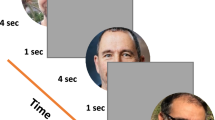Abstract
The eyes are often inspected first and for longer period during face exploration. To examine whether this saliency of the eye region at the early stage of face inspection is attributed to its local structure properties or to the knowledge of its essence in facial communication, in this study we investigated the pattern of eye movements produced by rhesus monkeys (Macaca mulatta) as they free viewed images of monkey faces. Eye positions were recorded accurately using implanted eye coils, while images of original faces, faces with scrambled eyes, and scrambled faces except for the eyes were presented on a computer screen. The eye region in the scrambled faces attracted the same proportion of viewing time and fixations as it did in the original faces, even the scrambled eyes attracted substantial proportion of viewing time and fixations. Furthermore, the monkeys often made the first saccade towards to the location of the eyes regardless of image content. Our results suggest that the initial fixation placement in faces is driven predominantly by “top–down” or internal factors, such as the prior knowledge of the location of “eyes” within the context of a face.



Similar content being viewed by others
References
Bruce V, Young A (1998) In the eye of the beholder. Oxford University Press, New York
Carpenter RH, Williams ML (1995) Neural computation of log likelihood in control of saccadic eye movements. Nature 377:59–62
Emery NJ (2000) The eyes have it: the neuroethology, function and evolution of social gaze. Neurosci Biobehav Rev 24:581–604
Farroni T, Csibra G, Simion F, Johnson MH (2002) Eye contact detection in human from birth. Proc Natl Acad Sci USA 99:9602–9605
Ghazanfar AA, Santos LR (2004) Primate brains in the wild: the sensory bases for social interactions. Nat Rev Neurosci 5:603–616
Ghazanfar AA, Nielsen K, Logothetis NK (2006) Eye movements of monkey observers viewing vocalizing conspecifics. Cognition 101:515–529
Gothard KM, Erickson CA, Amaral DG (2004) How do rhesus monkeys (Macaca mulatta) scan faces in a visual paired comparison task? Anim Cogn 7:25–36
Guo K, Robertson RG, Mahmoodi S, Tadmor Y, Young MP (2003) How do monkeys view faces?—a study of eye movements. Exp Brain Res 150:363–374
Guo K, Robertson RG, Mahmoodi S, Young MP (2005) Centre–surround interactions in response to natural scene stimulation in the primary visual cortex. Eur J Neurosci 21:536–548
Guo K, Mahmoodi S, Robertson RG, Young MP (2006) Longer fixation duration while viewing face images. Exp Brain Res 171:91–98
Henderson JM (2003) Human gaze control during real-world scene perception. Trends Cog Sci 7:498–504
Keating CF, Keating EG (1982) Visual scan patterns of rhesus monkeys viewing faces. Perception 11:211–219
Langton SR, Watt RJ, Bruce II (2000) Do the eyes have it? Cues to the direction of social attention. Trends Cogn Sci 4:50–59
Mannan SK, Ruddock KH, Woodings DS (1997) The relationship between the locations of spatial features and those of fixations made during visual examination of briefly presented images. Spatial Vis 10:165–188
Nahm FKD, Perret A, Amaral DG, Albright TD (1997) How do monkeys look at faces? J Cogn Neurosci 9:611–623
Noton D, Stark L (1971) Scanpaths in saccadic eye movements while viewing and recognizing patterns. Vis Res 11:929–942
Parkhurst D, Law K, Niebur E (2002) Modelling the role of salience in the allocation of overt visual attention. Vis Res 42:107–123
Parr LA, Winslow JT, Hopkins WD (2000) Recognizing facial cues: individual discrimination by chimpanzees (Pan troglodytes) and rhesus monkeys (Macaca mulatta). J Comp Psychol 114:1–14
Peters RJ, Iver A, Itti L, Koch C (2005) Components of bottom–up gaze allocation in natural images. Vision Res 45:2397–2416
Rauschenberger R (2003) Attentional capture by auto- and allo-cues. Psychon Bull Rev 10:814–842
Thomsen CE (1974) Eye contact by non-human primates toward a human observer. Anim Behav 22:144–149
Yarbus A (1967) Eye movements and vision. Plenum, New York
Author information
Authors and Affiliations
Corresponding author
Rights and permissions
About this article
Cite this article
Guo, K. Initial fixation placement in face images is driven by top–down guidance. Exp Brain Res 181, 673–677 (2007). https://doi.org/10.1007/s00221-007-1038-5
Received:
Accepted:
Published:
Issue Date:
DOI: https://doi.org/10.1007/s00221-007-1038-5




